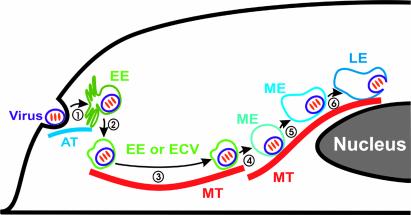Fig. 5.
A model of the endocytic pathway toward late endosomes. (1) The virus is internalized and transported to the early endosome (EE) in an actin (AT)-dependent way (stage I movement). (2) The virus-containing endocytic compartment leaves the EE, still at the extracellular pH. This may occur either through a virus-bearing endocytic carrier vesicle (ECV) budding from the EE (13, 27) or the membrane-rich tubular region of the EE recycling to leave a more vesicular EE that contains the virus (33). (3) The ECV or vesicular EE is transported to the perinuclear region via a dynein-directed movement on a microtubule (MT) (stage II movement). (4) The ECV or vesicular EE matures into a maturing endosome (ME) by changing the membrane-bound motor protein activity (transition from stage II to stage III movement). (5) The endosome further matures by changing its pH from the extracellular value to pH ≈6 (initial acidification as indicated by the change in fluorescence ratio between CypHer 5 and Cy3 conjugated to viruses). (6) Further acidification brings the pH of the endosome to the late endosomal (LE) value, pH ≈5 (second acidification as indicated by viral fusion).

